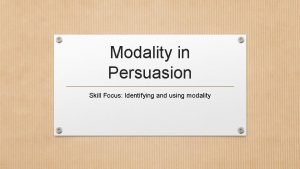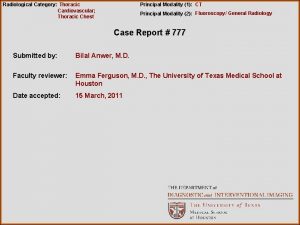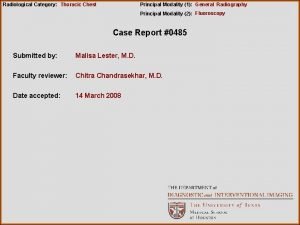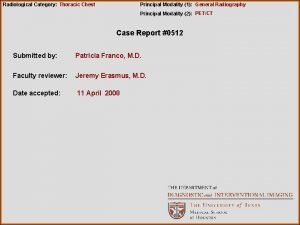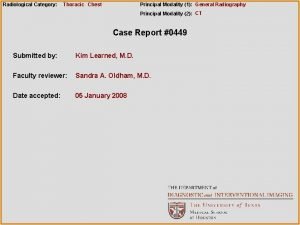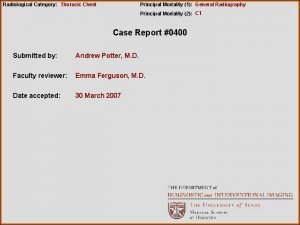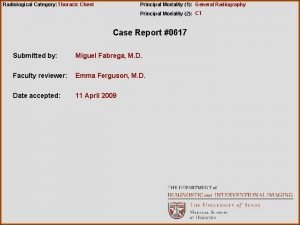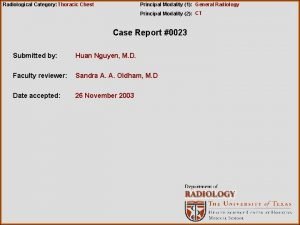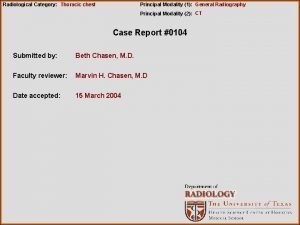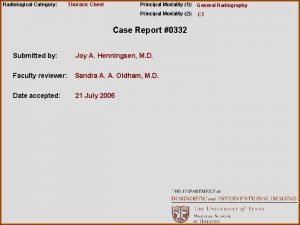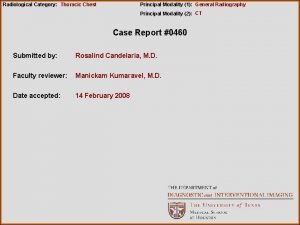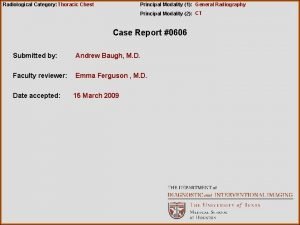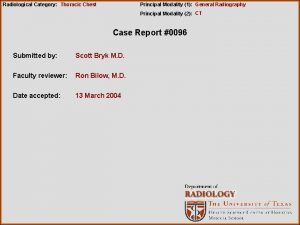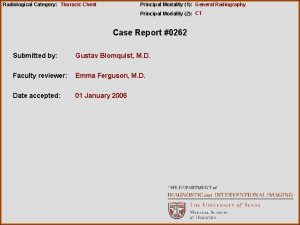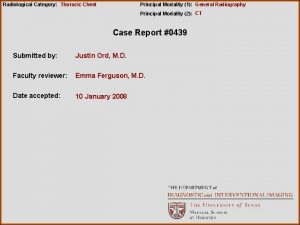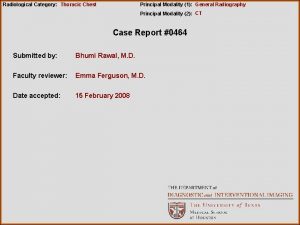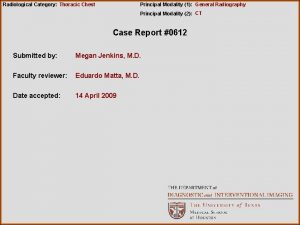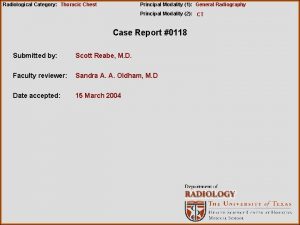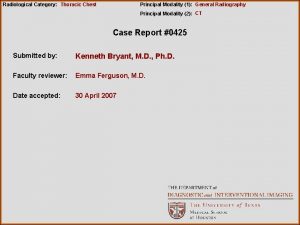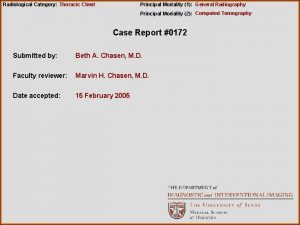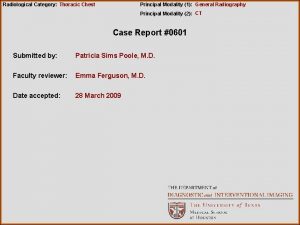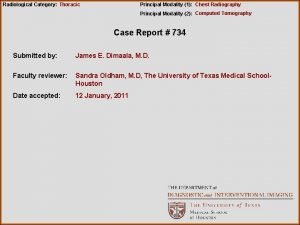Radiological Category Thoracic Chest Principal Modality 1 General























- Slides: 23

Radiological Category: Thoracic Chest Principal Modality (1): General Radiography Principal Modality (2): CT Case Report #0343 Submitted by: Amy Mehollin-Ray, M. D. Faculty reviewer: Emma Ferguson, M. D. Date accepted: 15 January 2007 This case and all other included images were presented at the 92 nd meeting of the Radiological Society of North America, 26 November – 1 December 2006, Abstract reference #LL-CH 4544.

Case History A 64 -year old woman presented to her primary care physician with complaints of low-grade fever, malaise, and chronic productive cough for approximately two months. Past medical history was pertinent for breast cancer several years ago, treated with mastectomy and chemotherapy. On exam, the patient was afebrile. On auscultation, coarse crackles were appreciated at the right lung base. A chest radiograph was obtained.

Radiological Presentations

Test Your Diagnosis Which one of the following is your choice for the appropriate diagnosis? After your selection, go to next page. • Pneumonia • Atelectasis • Bronchiectasis • Emphysema

Findings and Differentials Findings: Linear, parallel opacities are present in the right middle lobe. These opacities represent the thickened walls of dilated bronchi. A right-sided Port-a-Cath is also in place. Differentials: • Aspiration pneumonia • Chronic bacterial pneumonia • Mycobacterium avium complex (MAC) pneumonia • Idiopathic pulmonary fibrosis (IPF) A CT scan was ordered to evaluate the pulmonary findings.

Radiological Presentations

Findings and Differentials Findings: There is extensive bronchiectasis in the right middle lobe. Bronchiectasis is also seen in the lingula. Small alveolar opacities are arranged in a tree-in-bud distribution in portions of the right lower lobe. Differentials: • Mycobacterium avium complex (MAC) pneumonia • Chronic bacterial pneumonia

Discussion Pulmonary infection with Mycobacterium avium complex (MAC) most often occurs in immunocompromised patients, such as those patients with AIDS. In patients with normal immune systems, preexisting lung disease (i. e. COPD, bronchiectasis, cystic fibrosis) is the greatest risk factor for developing MAC pneumonia. However, elderly women without underlying lung disease may develop MAC pneumonia with bronchiectasis, most commonly in the right middle lobe and/or lingula. Patients may present with chronic cough productive of sputum. This pattern of infection is known as Lady Windermere syndrome. Diagnosis is made by AFB culture from sputum and/or bronchoalveolar lavage in the setting of suggestive physical exam and imaging findings. In patients with underlying lung disease, small nodules as well as cavities may be seen in the upper lobes. In patients without preexisting lung disease, bronchiectasis in the right middle lobe and lingula is typical. Tree-in-bud opacities may also be seen. High-resolution CT is more sensitive than plain radiographs in evaluating these abnormalities.

Discussion – Bronchiectasis is defined as irreversible dilatation of bronchi. Although infection is the most common cause, congenital abnormalities of the airways, central airway obstruction, and pulmonary fibrosis may also result in bronchiectasis. On plain radiographs, dilated bronchi may appear as tubular structures or cysts. Bronchial wall thickening may be seen. Air-fluid levels in cysts may occur in the setting of bacterial superinfection. Branching tubular opacities are typical of mucus impaction (finger-in-glove). Bronchography was once considered the gold standard for the diagnosis and evaluation of bronchiectasis, but this has been replaced by high-resolution CT.

Discussion – Cylindrical Bronchiectasis is typically classified as cylindrical, varicose, and cystic. In cylindrical bronchiectasis, the bronchi demonstrate smooth dilatation without normal tapering. On plain radiographs, this may produce a “tram track” appearance from thickened, parallel bronchial walls. On CT, bronchi imaged in the axial plane will appear tubular, while those cut in cross-section will demonstrate the “signet ring” sign – a dilated bronchus accompanied by its smaller pulmonary arterial branch.

Discussion – Varicose Bronchiectasis Varicose bronchiectasis is characterized by dilated bronchi with sites of constriction. On CT, bronchi seen in the plane of the image will have a beaded appearance, known as the “string of pearls. ” Bronchi cut in cross-section may mimic cylindrical bronchiectasis. Bronchography image courtesy of Dr. Goldman

Discussion – Cystic Bronchiectasis On plain radiographs, cystic bronchiectasis may appear as clusters of cysts. On CT, cysts with discernible walls may be arrayed in strings or clusters (“cluster of grapes”). Superinfection will produce air-fluid levels in some cysts. Pseudomonas aeruginosa is the most common pathogen in bacterial superinfection of preexisting bronchiectasis.

Discussion – Traction Bronchiectasis Traction bronchiectasis occurs not from damage to the bronchial wall itself, but from tension on the bronchus from architectural distortion and fibrosis in the adjacent lung parenchyma. It can be seen in any of the diseases that result in endstage lung disease, such as idiopathic pulmonary fibrosis (IPF) and collagen vascular diseases like systemic sclerosis. Traction bronchiectasis is also commonly seen in the upper lobes in patients with prior tuberculosis and chronic lung disease related to sarcoidosis. Fibrosis and traction bronchiectasis can occur in the radiation field following external beam radiation therapy.

Discussion – Distribution The distribution of bronchiectasis can provide clues to possible etiologies. Bronchiectasis may be described as diffuse (involving all lobes) or localized. If diffuse, bronchiectasis may have an apical or basal predominance, or may affect the central bronchi more than the peripheral bronchi. Congenital abnormalities of the airways typically cause diffuse bronchiectasis. Cystic fibrosis, for example, causes diffuse bronchiectasis which is often more pronounced at the apices. Childhood viral illnesses, such as RSV and measles, also may cause diffuse bronchiectasis. Lobar bronchiectasis is most commonly the result of infection. The lobar distribution may be helpful in narrowing the differential diagnosis. As in our case, the right middle lobe and/or lingula are most commonly affected in Mycobacterium avium complex (MAC) pneumonia. In contrast, the basal and/or posterior segments are affected in patients with chronic aspiration pneumonia, with sparing of the right middle lobe and lingula. The upper lobes are most commonly affected in patients with tuberculosis and sarcoidosis. Traction bronchiectasis in a nonanatomic distribution, conforming to the radiation field, may be seen following external beam radiation therapy.

Discussion – Cystic Fibrosis This CT image from another patient with cystic fibrosis demonstrates areas of bronchiectasis (“signet ring” sign) and tree-in-bud opacities, which are the result of mucus impaction. The plain radiograph of this patient with cystic fibrosis demonstrates diffuse bronchiectasis, which is more severe in the upper lobes. The lungs are hyperexpanded.

Discussion – Alpha 1 -Antitrypsin Deficiency Basilar panacinar emphysema is typical of alpha 1 -antitrypsin deficiency. The airways are damaged by increased protease activity, and this mechanism is thought to be the cause for bronchiectasis as well as emphysema. Other congenital causes of bronchiectasis include dyskinetic cilia syndrome, Mounier-Kuhn syndrome, and Williams. Campbell syndrome.

Discussion – Childhood Infection Childhood respiratory infections, such as RSV, measles, and pertussis, can lead to diffuse bronchiectasis. Dilated airways and impaired clearance make these patients more susceptible to recurrent bacterial infections. Air-fluid levels in this patient with severe cystic bronchiectasis indicate active bacterial infection.

Discussion – Chronic Aspiration Pneumonia Recurrent aspiration pneumonia most commonly affects the superior segments of the lower lobes and posterior segments of the upper lobes in patients who are supine. The basal segments of the lower lobes are affected in patients who are upright. The right middle lobe and lingula are rarely affected.

Discussion – Pneumocystis jiroveci Pneumonia Bronchiectasis is occasionally a finding in patients with Pneumocystis pneumonia. More often, bilateral perihilar opacities are seen on plain film, and ground glass opacities are seen on a background of interlobular septal thickening on HRCT. Patients with HIV may develop bronchiectasis secondary to lymphocytic interstitial pneumonia. These patients are also more susceptible to Aspergillus and recurrent bacterial infections.

Discussion – Tuberculosis Upper lobe fibronodular opacities, hilar retraction, and volume loss are typical of chronic post-primary tuberculosis. Bronchiectasis is a common finding.

Discussion – Idiopathic Pulmonary Fibrosis On CT, characteristic findings include septal and intralobular thickening, honeycombing, and traction bronchiectasis. Ground-glass opacities represent areas of active alveolitis.

Discussion – Radiation Fibrosis This patient underwent external beam radiation therapy for breast cancer. Radiation fibrosis may develop 6 -12 months after therapy, and conforms to the shape of the radiation field. Traction bronchiectasis and volume loss are typical. The adjacent lung is often hyperexpanded.

Diagnosis Mycobacterium avium complex (MAC) pneumonia. References Webb WR, Müller NL, Naidich DP: High-resolution CT of the lung, ed 3, Philadelphia, 2001, Lippincott, Williams, & Wilkins. Fraser RS, Müller NL, Coleman N, Paré PD: Fraser and Paré’s diagnosis of diseases of the chest, ed 4, Philadelphia, 1999, W. B. Saunders. Lynch DA, Travis WD, Müller NL, et al. Idiopathic interstitial pneumonias: CT features. Radiology. 2005 Jul; 236(1): 10 -21. Erasmus JJ, Mc. Adams HP, Farrell MA, Patz EF Jr. Pulmonary nontuberculous mycobacterial infection: radiologic manifestations. Radiographics. 1999 Nov. Dec; 19(6): 1487 -505. King MA, Stone JA, Diaz PT, et al. Alpha 1 -antitrypsin deficiency: evaluation of bronchiectasis with CT. Radiology. 1996; 199: 137 -141.
 Erate category 2
Erate category 2 Radiological dispersal device
Radiological dispersal device Tennessee division of radiological health
Tennessee division of radiological health Center for devices and radiological health
Center for devices and radiological health National radiological emergency preparedness conference
National radiological emergency preparedness conference Modality in statistics
Modality in statistics Past tense in xhosa
Past tense in xhosa Modality in software engineering
Modality in software engineering Modality in software engineering
Modality in software engineering Deontic and epistemic modality exercises
Deontic and epistemic modality exercises Modality in software engineering
Modality in software engineering Data modeling fundamentals
Data modeling fundamentals Modality
Modality Skill focus: persuasion
Skill focus: persuasion Pacs modality workstation
Pacs modality workstation Monode electrode
Monode electrode Characteristics of sensory neurons
Characteristics of sensory neurons Epistemic modality
Epistemic modality Sodality vs modality
Sodality vs modality One to many relationship line
One to many relationship line Cardinality and modality
Cardinality and modality Cardinality and modality
Cardinality and modality Modality microsoft services
Modality microsoft services Epistemic modality
Epistemic modality













